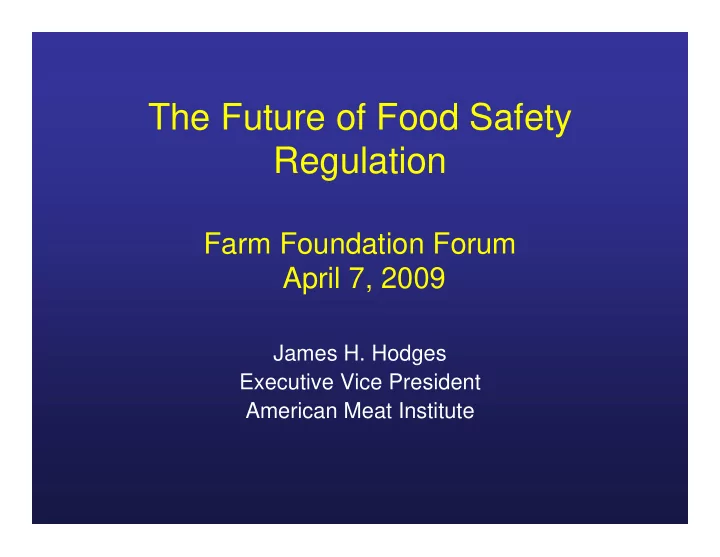

The Future of Food Safety Regulation Farm Foundation Forum April 7, 2009 James H. Hodges Executive Vice President American Meat Institute
About AMI • Members process more than 90 % of nation's beef, pork, lamb, veal • Several members have substantial poultry interests • Food safety is industry’s top priority • Food safety is a non-competitive issue
Is Food Safety System Broken? • Not for meat and poultry • Illness associated with meat and poultry consumption have declined • Billion meals consumed each day without incident
Percentage of Illnesses by Foodborne Pathogens Bacterial Parasitic Viral 66.6% - Norwalk-like Viruses 14.2% - Campylobacter spp. 9.7% - Salmonella 30.20% 0.5% - E. coli O157:H7 0.3% - E. coli , non-O157:H7 STEC 67.20% 0.0% - Listeria monocytogenes 2.60% Mead et al. (1999)
Deaths for 10 Leading Causes of Death, All Ages, 2006 Foodborne Illness Other Disease of Heart Septicemia Nephritis, nephrotic syndrome and nephrosis Influenza and pneumonia Diabetes mellitus Alzheimer's malignant neoplasms Accidents chronic lower respitory diseases cerebrovasular diseases Source: National Vital Statistics Reports, Vol. 56, No. 16, June 11, 2008 Total Deaths: 2,425,901 Total Other: 576,491 of which estimate 5,000 are caused by Foodborne Illness
A Comparison of Resources for Food Oversight Agencies Food Safety and Food and Drug Inspection Service Administration (Foods Only) Funding (FY09) $1.11 billion $649 million Staff (est. field 8,000 1,900 only) Domestic 6,300 slaughter 136,000 facilities Facilities and/or processing establishments
Robust FSIS Import Inspection • 33 foreign countries equivalent • Annual foreign audits • 75 import inspectors at 150 official import establishments • Routine product inspection and analysis
Strong Preventative Measures Mandatory Hazard Analysis Critical Control Points Programs • Hazard analysis • Critical Control Points • Critical limits • Monitoring • Corrective actions • Recordkeeping • Verification
FSIS Assures Processes Are Validated • In-depth Food Safety Audits • Environmental sanitation monitoring • Extensive product sampling
FSIS Microbiological Tests Salmonella Raw Products 41,805 RTE Products 11,651 E. coli O157:H7 Ground Beef 11,607 Beef Products 2,836 Listeria All Products 12,665 Total Micro Tests: 80,564
FSIS Continuously Monitors Plant Sanitation • SSOP Programs • Immediate corrective action
Lower Pathogen Prevalence Shows System Works
Prevalence of E. coli O157:H7 in Ground Beef* 45% Reduction 1 Percent Positives 0.8 0.6 0.4 0.2 0 00 08 Fiscal Year
Prevalence of Listeria monocytogenes in RTE Meat and Poultry Products* 74% Reduction 1.6 Percent Positives 1.4 1.2 1 0.8 0.6 0.4 0.2 0 00 07 Year *FSIS results of ready-to-eat products analyzed for Listeria monocytogenes
Lower Illness Incidence Shows System Works
Incidence of Foodborne Illness 2000-2007: E. coli O157* 2.5 40% Reduction 2 Incidence per 100,000 Population 1.5 1 0.5 0 2000 2007 Year *Preliminary FoodNet Data on the Incidence of Infection with Pathogens Transmitted Commonly Through Food --- 10 states, 2007
Incidence of Foodborne Illness 2000-2007: Listeria* 0.305 0.3 10% Reduction 0.295 Incidence per 100,000 Population 0.29 0.285 0.28 0.275 0.27 0.265 0.26 0.255 2000 2007 Year *Preliminary FoodNet Data on the Incidence of Infection with Pathogens Transmitted Commonly Through Food --- 10 states, 2007
Are Performance Standards Needed?
Prevalence of Salmonella in Chickens* 25 20 Percent Positives 58% Reduction 15 10 5 0 Performance Standard 2007 *FSIS results of broilers analyzed for Salmonella
Prevalence of Salmonella in Pork* 10 9 68% Reduction 8 Percent Positives 7 6 5 4 3 2 1 0 Performance Standards 2007 *FSIS results of market hogs analyzed for Salmonella
Prevalence of Salmonella in Ground Beef* 8 7 64% Reduction Percent Positives 6 5 4 3 2 1 0 Performance Standard 2007 *FSIS results of ground beef analyzed for Salmonella
Incidence of Foodborne Illness 2000-2007: Salmonella* 15 5% Increase 14.8 Incidence per 100,000 Population 14.6 14.4 14.2 14 13.8 2000 2007 Year *Preliminary FoodNet Data on the Incidence of Infection with Pathogens Transmitted Commonly Through Food --- 10 states, 2007
Are Performance Standards Needed? • Yes, if properly constructed to achieve public health protection • Must be objective and scientifically-based to measure if food is safe and non- injurious to public health
Are Performance Standards Needed? • No, if solely based on achieving arbitrary outcome that yields no public health protection • Existing Salmonella performance standards have lowered product prevalence but not improved human health
Will More Enforcement Authority Spur Improvement? • FSIS can detain and seize products • FSIS can condemn products • FSIS can shut down plant • FSIS can withdraw inspection • FSIS can criminally prosecute management
Is Mandatory Recall Necessary? • Industry has business incentive to recall product • Speed of removing contaminated product from market will not improve • Industry cooperation to execute recalls has been excellent • FSIS can detain and seize product without court order • FSIS has ability to issue press release stating company is uncooperative
What Will Improve Food Safety?
Elements of an Effective Food Safety Program • Focus on public health protection • Focus on preventive process control systems • Adequate publicly-funded resources • Resources allocated to public health risk • Objective, measurable, achievable, science-based food safety standards
Elements of an Effective Food Safety Program • Compatibility with recognized international standards • Better analysis and reporting of outbreak investigations • Rigorous government inspection and testing to verify product safety • Public/private research partnership
The Future of Food Safety Regulation Farm Foundation Forum April 7, 2009 James H. Hodges Executive Vice President American Meat Institute
Recommend
More recommend